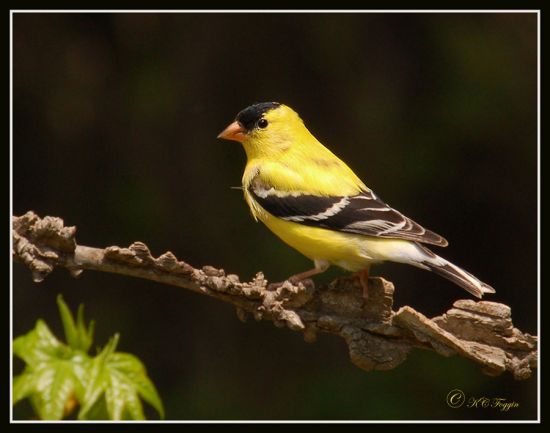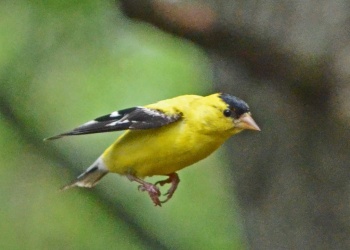- Spinus tristis
Carduelis tristis
Identification
4 1/2-5" (11-13 cm).
Breeding male
- Bright yellow with a white rump
- Black forehead
- White edges on black wings and tail
- Yellow at bend of wing.
Female and winter male
- Duller and grayer with black wings and tail
- Wing bars are white in adults, buffy in immatures.
- Male has more yellow on chin and face.
Distribution
North America, Canada, United States, Central America
Canada: Alberta, British Columbia, Manitoba, New Brunswick, Newfoundland, Nova Scotia, Ontario, Prince Edward Island, Quebec, Saskatchewan
United States of America: New England, Alabama, Arkansas, Arizona, California, Colorado, Connecticut, District of Columbia, Delaware, Florida, Georgia, Iowa, Idaho, Illinois, Indiana, Kansas, Kentucky, Louisiana, Massachusetts, Maryland, Maine, Michigan, Minnesota, Missouri, Mississippi, Montana, North Carolina, North Dakota, Nebraska, New Hampshire, New Jersey, New Mexico, Nevada, New York, Ohio, Oklahoma, Oregon, Pennsylvania, Rhode Island, South Carolina, South Dakota, Tennessee, Texas, Utah, Virginia, Vermont, Washington, Wisconsin, West Virginia, Wyoming
Central America: Mexico: Baja California, Sonora, Chihuahua, Coahuila, Nuevo Leon, Tamaulipas, Zacatecas, Hidalgo, Tlaxcala, Puebla, Veracruz, Oaxaca
Taxonomy
Formerly included in genus Carduelis.
Subspecies
Four subspecies are recognized[1]:
- S. t. jewetti:
- South-western British Columbia to south-western Oregon (west of the Cascades)
- S. t. pallida:
- South-central British Columbia to [[west-central US; winters to Puebla and Veracruz
- S. t. salicamans:
- California (west of Sierra Nevada) to north-western Baja California
- S. t. tristis:
Habitat
Brushy thickets, weedy grasslands, and nearby trees.
Behaviour
Actions
Undulating flight often in flocks.
Breeding
4 or 5 pale blue eggs are laid in a well-made cup of grass, bark strips, and plant down, placed in the upright fork of a small sapling or a shrub. Nests later in summer than other songbirds making it possible to use thistle down in constructing nests.
Diet
Strict vegetarian. They eat a wide variety of seeds with a preference for thistle. Also shoots and buds of trees and flowering plants and sometimes tree sap. Occasional insects.
Vocalisation
Call: "per-chick-o-ree", also rendered as "potato-chips", delivered in flight and coinciding with each undulation. Song is a long, rambling jumble of sweet and melodious notes interspersed with thin twittering and trills.
Movements
Resident, migratory and partially migratory. Southern populations largely resident or make short-distance movements to non-breeding areas. Northern population predominantly migratory, females moving farther south than males.
References
- Clements, J. F., T. S. Schulenberg, M. J. Iliff, S. M. Billerman, T. A. Fredericks, B. L. Sullivan, and C. L. Wood. 2019. The eBird/Clements Checklist of Birds of the World: v2019. Downloaded from http://www.birds.cornell.edu/clementschecklist/download/
- Lepage D. (2020) American_Goldfinch in Avibase - The World Bird Database. Retrieved 30April 2020
- American Goldfinch - whatbird.com identify.whatbird.com
- McGraw, K. J. and A. L. Middleton (2020). American Goldfinch (Spinus tristis), version 1.0. In Birds of the World (P. G. Rodewald, Editor). Cornell Lab of Ornithology, Ithaca, NY, USA. https://doi.org/10.2173/bow.amegfi.01
- Clement, P. (2020). American Goldfinch (Spinus tristis). In: del Hoyo, J., Elliott, A., Sargatal, J., Christie, D.A. & de Juana, E. (eds.). Handbook of the Birds of the World Alive. Lynx Edicions, Barcelona. (retrieved from https://www.hbw.com/node/61356 on 30 April 2020).
Recommended Citation
- BirdForum Opus contributors. (2025) American Goldfinch. In: BirdForum, the forum for wild birds and birding. Retrieved 14 March 2025 from https://www.birdforum.net/opus/American_Goldfinch
External Links
GSearch checked for 2020 platform.1







